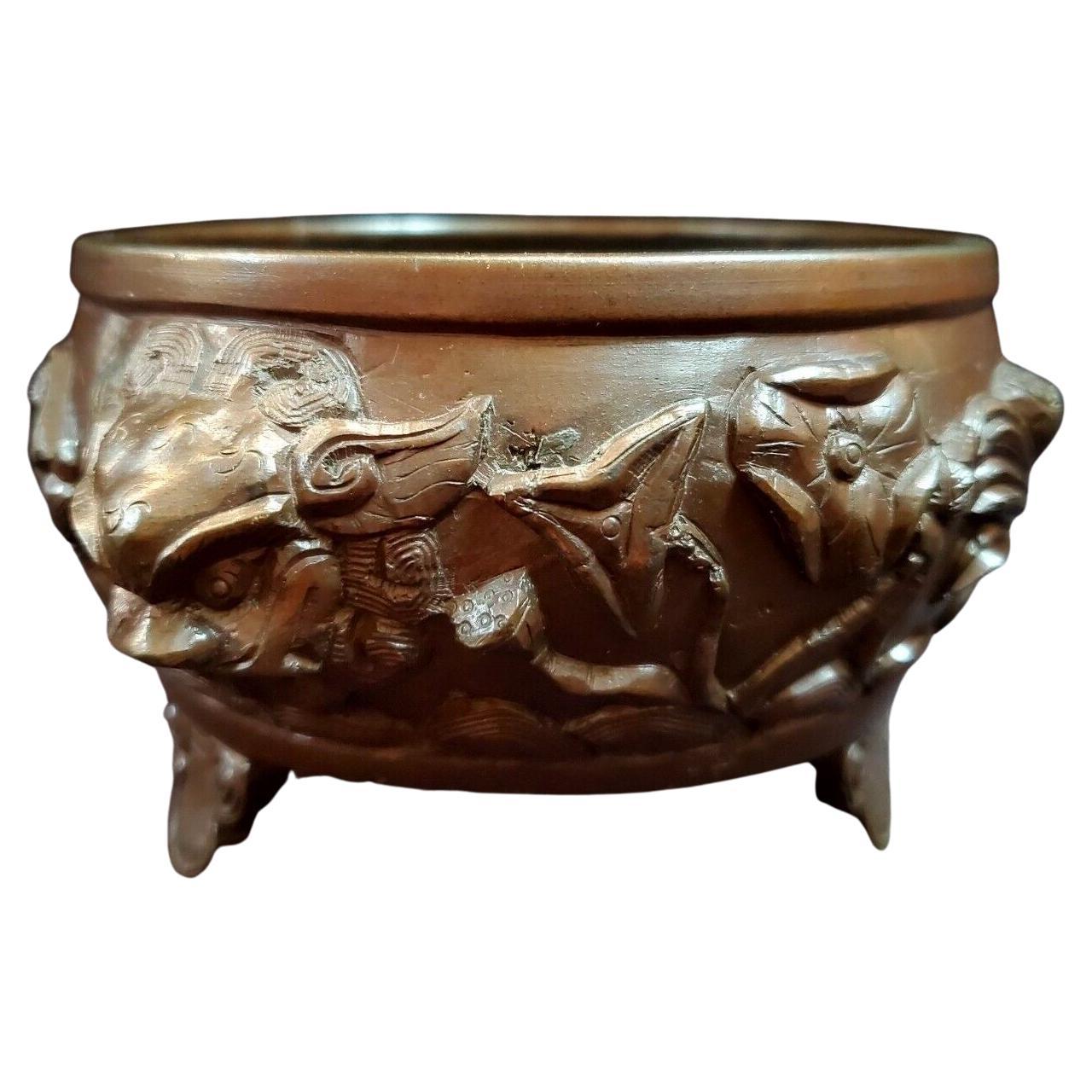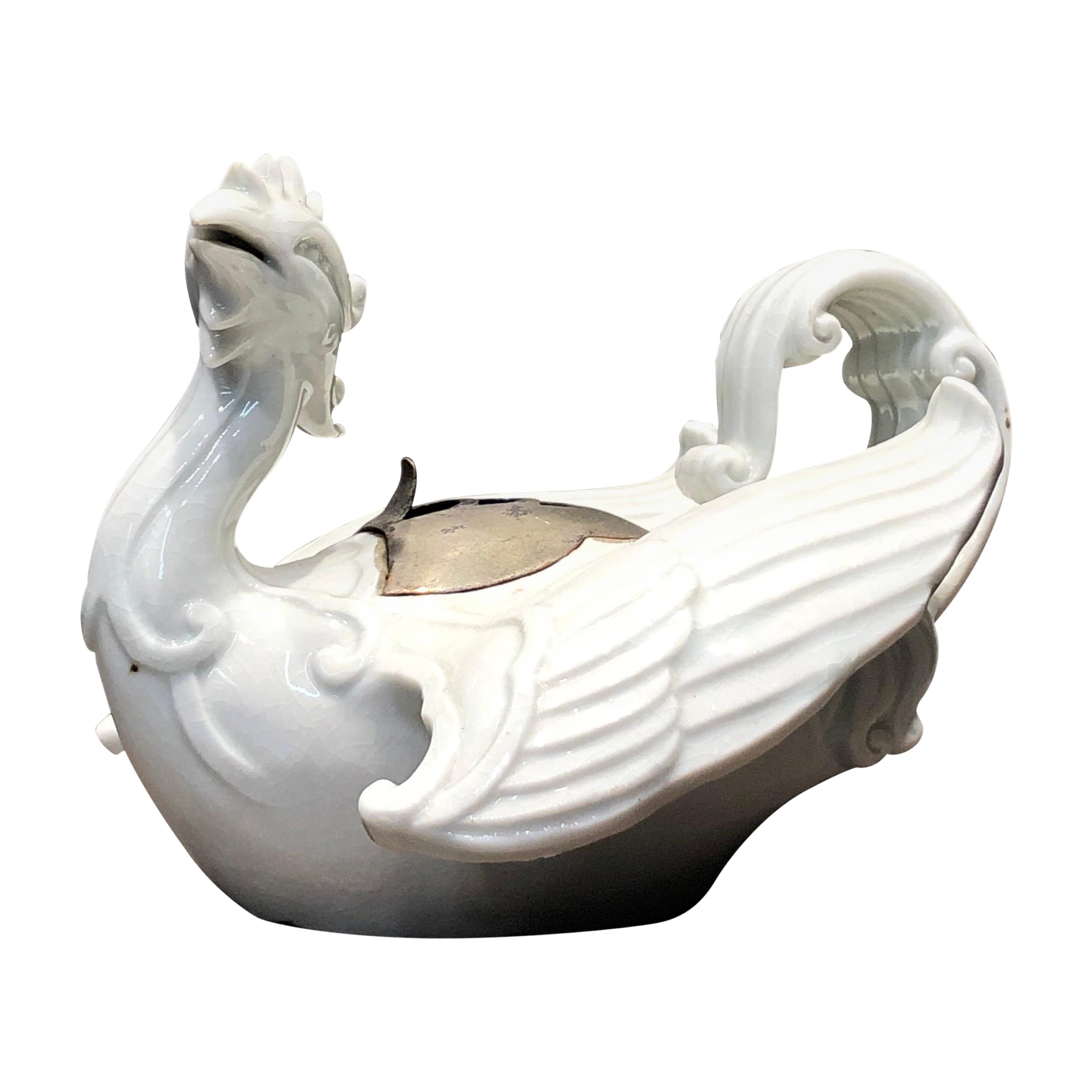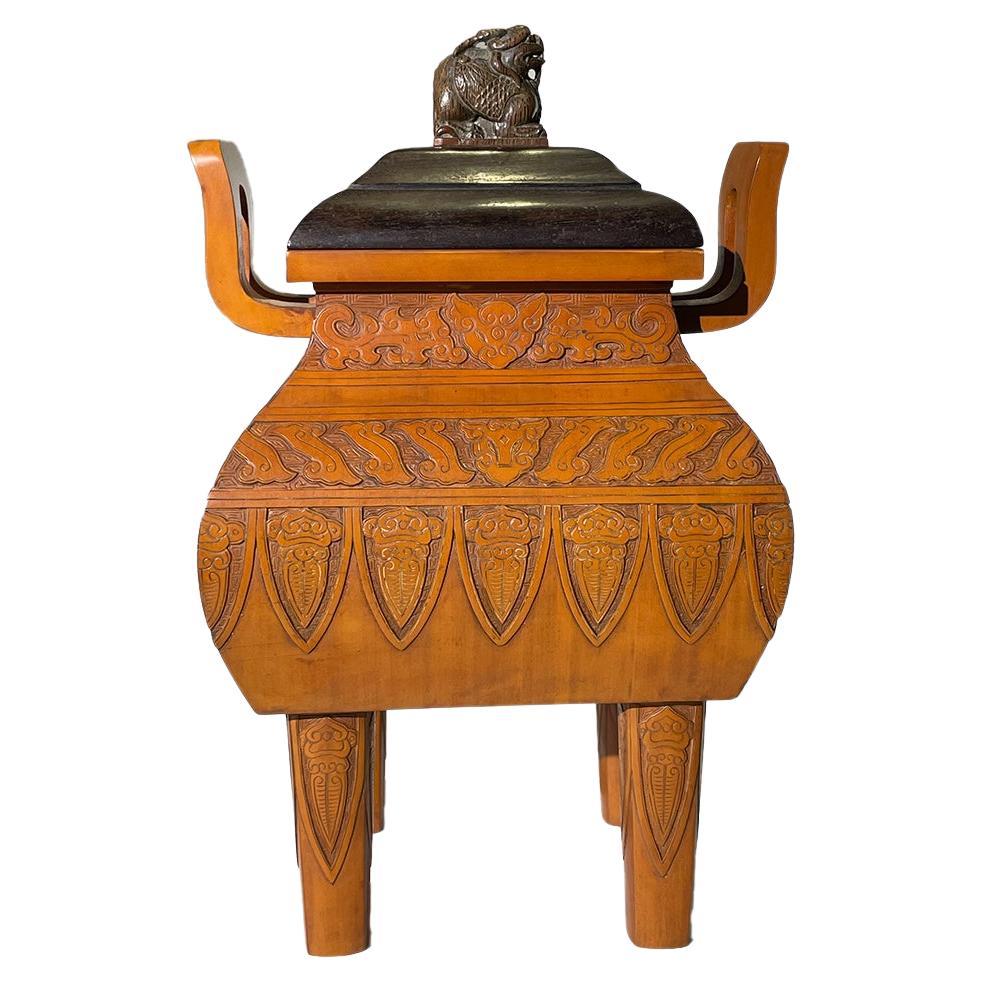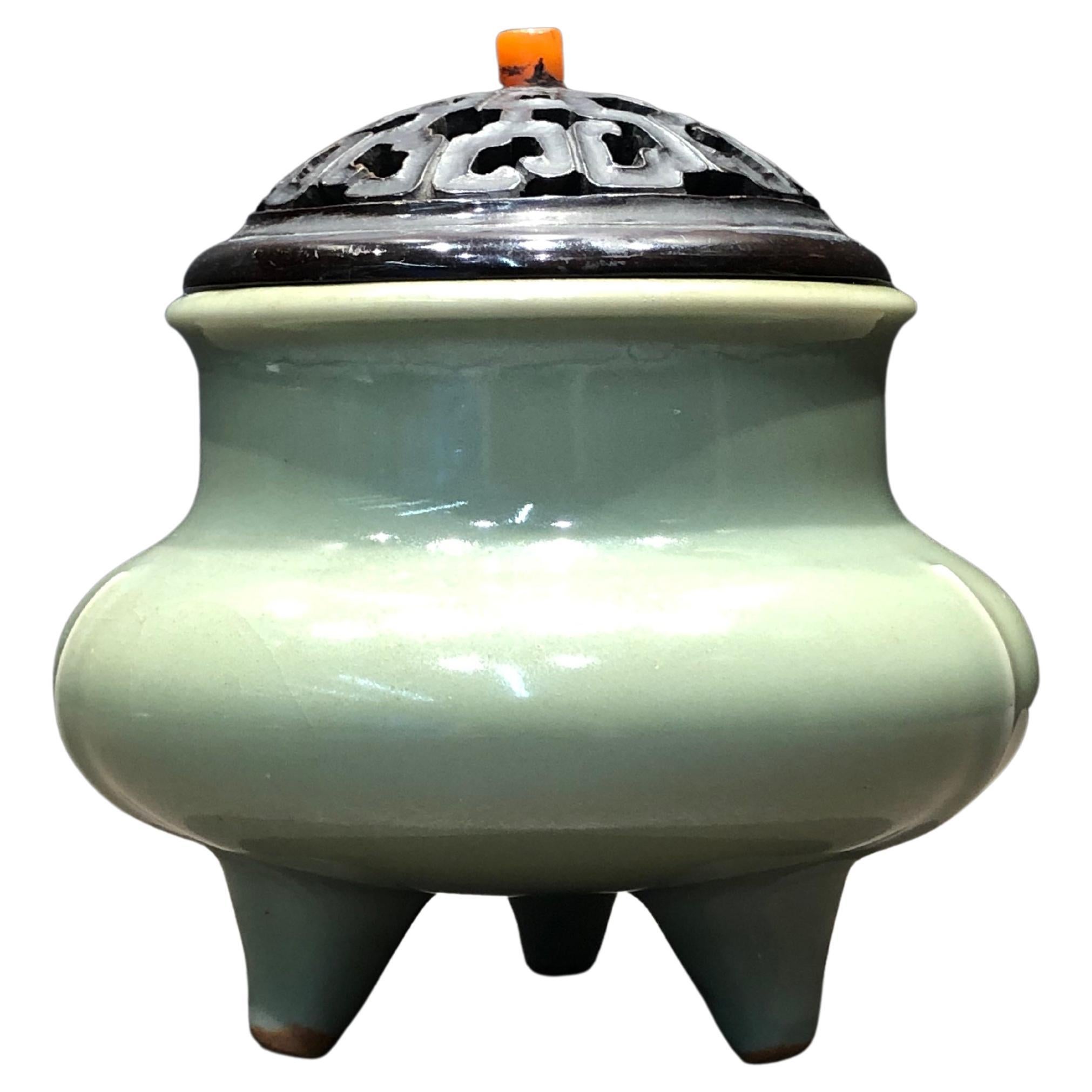Items Similar to Yellow Kyouyaki Incense Burner with Silver Lid with Lotus Design, Taisho Period
Want more images or videos?
Request additional images or videos from the seller
1 of 5
Yellow Kyouyaki Incense Burner with Silver Lid with Lotus Design, Taisho Period
About the Item
Monochrome porcelain fired in Kyoto
The shape is modeled after an ancient Chinese incense burner.
It has a simple shape with eight strings and three legs in the shape of a ”ruyi” and thread and laced openwork lid made of silver.
A lotus pattern is painted on the lid using cloisonne enamel.
This is a piece suitable for Kodo.
*There is a restoration of kintsugi (metal joints) on the mouth rim.
- Dimensions:Height: 3.75 in (9.5 cm)Diameter: 4.34 in (11 cm)
- Style:Taisho (Of the Period)
- Materials and Techniques:
- Place of Origin:
- Period:
- Date of Manufacture:Taisho period
- Condition:Repaired: There is a restoration of kintsugi (metal joints) on the mouth rim. Wear consistent with age and use.
- Seller Location:Chuo-ku, JP
- Reference Number:1stDibs: LU6941231655742
About the Seller
5.0
Vetted Seller
These experienced sellers undergo a comprehensive evaluation by our team of in-house experts.
Established in 1995
1stDibs seller since 2022
- ShippingRetrieving quote...Ships From: Chuo-ku, Japan
- Return PolicyA return for this item may be initiated within 14 days of delivery.
More From This SellerView All
- Japanese Dot Designed China Teapot, Taisho PeriodLocated in Chuo-ku, TokyoThis piece made in Taisho period is imitation of Longquan ware celadon from the Yuan dynasty in China. The technique of skipping celadon is used. Ski...Category
20th Century Japanese Taisho Antiquities
MaterialsPorcelain
- White China Fenix Figured Incense Burner, Edo PeriodLocated in Chuo-ku, TokyoIncense burner with three-dimensional molding of Hirado ware(Origin in Hirado, Nagasaki prefecture) of the Edo period. Hirado ware is very famous for it...Category
Antique 18th Century Japanese Antiquities
MaterialsPorcelain
- Rare Chinese Antique Bamboo Incense Burner, Qing periodLocated in Chuo-ku, TokyoThis is a rare ding-shaped incense burner using bamboo. Ding (鼎) is a tool used in ancient Chinese magical rituals, and while bronze ware is common, this ...Category
Antique 17th Century Antiquities
MaterialsBamboo
- Four Seasons Flower and Birds Enamel Designed Silver Incense Burner, 19CLocated in Chuo-ku, TokyoIncense burner inlaid with cloisonne enamel on silver, made in the Meiji period. This is a gem of the Meiji period by Ipposai. The circular body, has eight demensions with four l...Category
Antique 19th Century Japanese Meiji Antiquities
MaterialsSilver
- Chinese Pale Green China Incense Burner with Wooden Lid with Handle of Red AgateLocated in Chuo-ku, TokyoCeladon glaze from the Longquan kiln of the Ming dynasty. The shape is a three-legged incense burner in the form of a "Li (A type of bronze ware)" from ...Category
Antique 16th Century Antiquities
MaterialsAgate
- Japanese Antique Bronze Fenix Shaped Insence Burnar, Taisho PeriodLocated in Chuo-ku, TokyoBeautiful phenix shaped incense burner with openwork.Category
20th Century Chinese Taisho Antiquities
MaterialsBronze
You May Also Like
- Qing, Early Period, High Relief Lotus Leaf Pattern Copper Incense BurnerLocated in San Gabriel, CAQing, Chinese antique early period high relief lotus leaf pattern copper incense burner/ ?,?? ?????????. Condition:Shows normal sign of wear and...Category
Antique Early 18th Century Chinese Antiquities
MaterialsBronze
- Chinese Bronze Incense Burner or CenserLocated in Los Angeles, CAChinese Bronze Censor believe to be from the 1800's. The pice is very substantial and heavy - the lid removes to reveal a solid bronze platform for incense. A wonderful piece and hig...Category
Antique 19th Century Chinese Antiquities
MaterialsBronze
- Celadon Incense Burner with Peony Arabesque Design/Chinese Antique/14th-17th CLocated in Kyoto-shi, KyotoThis is a Celadon three-legged incense burner with peony arabesque design. Since the 14th century, Dwarf sedge was planted in this pot to decorate the tea room, so in Japan it is ...Category
Antique 15th Century and Earlier Antiquities
MaterialsCeramic
- Japanese Edo-Meiji Period Satsuma Incense Burner (Koro) and Wooden Support TableLocated in North Miami, FLJapanese 19th century Edo-Meiji Period Satsuma stoneware incense burner (Koro) with small wooden support table By: unknown Material: ceramic, stoneware, wood, enamel, paint Techniqu...Category
Antique 19th Century Japanese Edo Antiquities
MaterialsEnamel
- Bronze Bird Incense Burner, China, 19th CenturyLocated in Paris, FRBronze bird incense burner. China, 19th century.Category
Antique 19th Century Chinese Antiquities
MaterialsBronze
- Rare Boshan Incense Burner Yue Celadon, Jin dynastyLocated in seoul, KRThe Boshan incense burner is particularly notable among Han dynasty incense burners for its unique shape. Designed to resemble a mountain or even a mythical mountain, it is characterized by its pointed peaks that rise upwards. These peaks often function as vents for the smoke, creating an effect reminiscent of a volcanic eruption. The body of the incense burner is typically round, with multiple small peaks surrounding a central, larger peak. The material used is mainly ceramic, although there are instances where they were made of bronze. It is presumed that this incense burner was used for religious or ceremonial purposes during its time. The colors of these burners are usually in shades of pale green or greyish brown, with the application of glaze to achieve a variety of colors on occasion. Such incense burners are often found in tombs or ritual sites, and their purpose was to burn incense for purification of space or to produce pleasant aromas. The Boshan incense burner also represents a significant cultural heritage, showcasing the craftsmanship and artistic values of the period. Today, it is considered a quintessential example of ancient Chinese art. Period : Han-Jin Dynasty Type : Incense Burner Medium : Yue celadon...Category
Antique 15th Century and Earlier Chinese Han Antiquities
MaterialsStoneware





